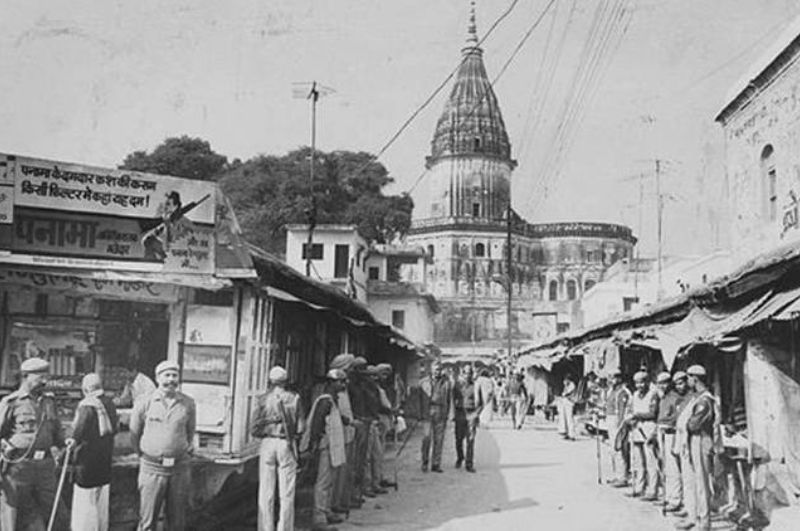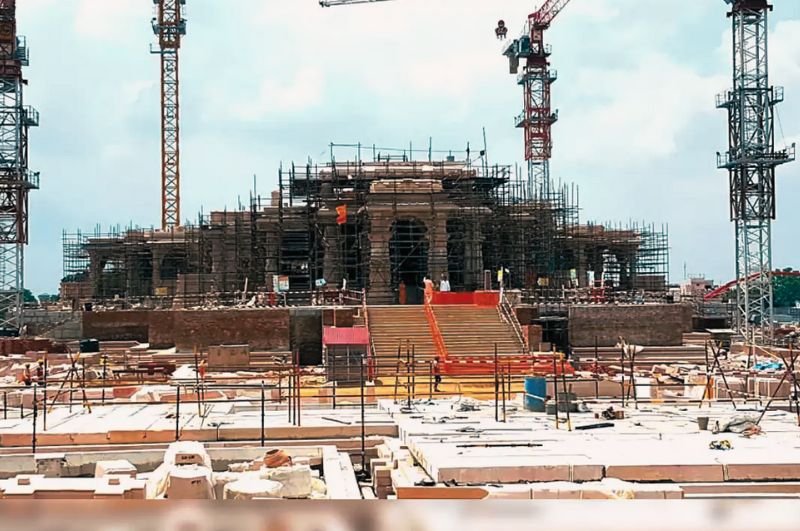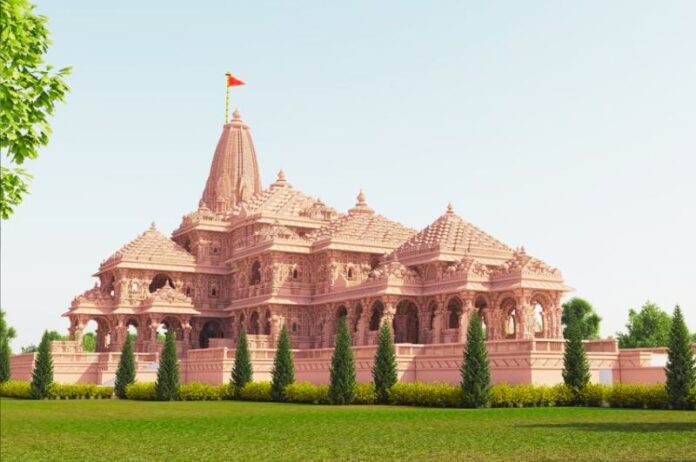They have scheduled the inauguration ceremony of the Ayodhya Ram Mandir for January 22, 2024. Prime Minister Narendra Modi will attend the event. Preparations for this grand inauguration ceremony will start on January 15, 2024.
Exploring the History of the Ram Mandir

In Sanatan Dharma, people worldwide revere Lord Shri Ram as the seventh incarnation of Lord Vishnu. According to the ancient epic Valmiki Ramayana, Ayodhya was Lord Shri Ram’s sacred birthplace in the Tretayuga. Ram Janmabhoomi, a revered site in Ayodhya, became controversial in the 15th century when Mughal ruler Babur, born in Andijan (now Uzbekistan), erected a mosque at Ram Janmabhoomi. Followers of Sanatan Dharma accused him of building it after demolishing a temple. This dispute has persisted since 1850.
Over the years, the Vishva Hindu Parishad has made several announcements regarding the construction of the Ram temple at this disputed site. In the 1990s, they even collected bricks inscribed with “Shri Ram” and funds for the temple’s construction. Although the government initially granted permission for temple construction, various factors delayed the project. In 1992, the controversy escalated to a violent incident when the Babri Masjid, the disputed structure, was demolished. Finally, in 2019, a five-judge bench of the Supreme Court of India ruled that the government should hand over the disputed site to a trust. Subsequently, the Shri Ram Janmbhoomi Teerth Kshetra Trust was formed, and they were entrusted with the land. Construction of the Ram Mandir began in March 2020 and is expected to be completed by 2024.
The Architecture and Construction of the Ram Mandir

The Ram Mandir’s original design, conceived by the Sompura family of Ahmedabad, dates back to 1988. This renowned family, known for designing more than a hundred temples across 15 generations, made modifications to the temple’s original design, which received subsequent approval when construction commenced in 2020. The Ram Mandir will measure 235 feet in width, 360 feet in length, and stand 161 feet tall. The temple is being constructed in the Nagara architectural style, a prominent Indian temple construction style. The primary architects overseeing this monumental project are Chandrakant Sompura and his two sons, Nikhil Sompura and Ashish Sompura.
Apart from the temple, there are plans for a prayer hall, Ram Katha Kunj, Vedic Pathshala, Sant Niwas, Yeti Niwas, a museum, and a cafeteria.
The Foundation Stone Laying Ceremony

On August 5, 2020, at noon, Prime Minister Narendra Modi laid the foundation stone for the Ayodhya Ram Mandir. Before this event, devotees conducted three days of Vedic rituals at Ram Janmabhoomi. They worshipped Lord Shri Ram and invited various deities to participate in the foundation stone-laying ceremony. Soil and holy water were collected from significant religious sites across India, including Sharda Peeth in Pakistan, and used during the rituals, which also included water from the Ganga, Indus, Yamuna, Saraswati, and Kaveri rivers. Over 7,000 lamps illuminated the Ayodhya Mandir to celebrate this momentous occasion.
Builders are constructing the temple on 2.7 acres of land in Ayodhya, encompassing a 54,700-square-foot area. The entire complex encompasses approximately 70 acres, providing ample space for thousands of devotees to gather and seek the blessings of Shri Ram simultaneously. Larsen & Toubro Company is overseeing the construction, utilizing sandstone sourced from the Bansi mountain in Rajasthan.
Ayodhya Ram Mandir: Historical Milestones
1528–1529: Mughal Emperor Babur constructs the Babri Masjid.
1850: Communal strife erupts over land disputes.
1949: The discovery of the Lord Rama idol inside the mosque escalates communal tensions.
1950: They filed two cases in the Faizabad Civil Court seeking permission to worship idols.
1961: The UP Sunni Central Waqf Board demands the statue’s removal.
1986: The district court opens the site for Hindu worship.
1992: Babri Masjid demolition on December 6th.
2010: Allahabad High Court orders the division of disputed land into three parts, allocated to the Sunni Waqf Board, Nirmohi Akhara, and Ram Lalla.
2011: The Supreme Court stays Allahabad High Court’s order.
2016: Subramanian Swamy petitions the Supreme Court, urging Ram temple construction.
2019: The Supreme Court acknowledges Ayodhya as Lord Ram’s birthplace, transferring 2.77 acres to the trust and allocating 5 acres to the Sunni Waqf Board.
2020: PM Modi performs Bhoomi Pujan and lays the foundation stone.
Design Elements of the Ram Mandir

Chandrakant Sompura and his sons, the architects of the temple, designed the temple with meticulous attention to detail. The temple entrance, following the Nagara style, faces east and showcases Gopuram-style architecture, representing southern temples. The temple walls will feature artifacts depicting the life of Lord Shri Ram.
The Ram Mandir will be three times larger than the existing structure, with an octagonal sanctum sanctorum constructed from Makrana marble. Standing at 161 feet in height, the temple will boast five domes and a tower, rising three stories high. The design of the sanctum sanctorum allows direct sunlight to fall upon Ramlala, the infant incarnation of Lord Shri Ram. Additionally, the temple complex will include the Griha Mandapa, Kirtan Mandapa, Nritya Mandapa, Rang Mandapa, and two Prarthana mandapas. Craftsmen will fashion all doors and windows from teak wood, renowned for its strength and durability, sourced from Chandrapur, Maharashtra.
The Temple’s Divine Idols
The temple will house two idols of God. One is an original statue discovered in 1949 that has been sheltered for decades. The second is a large statue currently under construction, created by transporting two Shaligram stones from the Kali Gandaki riverbanks in Mustang district, Nepal. The Shaligram stones, approximately six crores (60 million) years old, weigh 26 and 14 tonnes, respectively.
Shaligram stones, revered symbols of Lord Vishnu in Sanatan Dharma, are worshipped in countless households. Champat Rai, General Secretary of Shri Ram Janmabhoomi Teerth Kshetra, stated that the idol will portray Lord Ram at age five, as per Valmiki Ramayana. The sanctum sanctorum construction will be finished by September, and Ramlala’s idol will be ready in October.
The Grand Temple Bell
The temple will place a 2100 kg monumental bell, measuring 6 feet in height and 5 feet in width. Alongside it, they will install ten smaller bells of different sizes, with weights of 500, 250, and 100 kg, all crafted from a brass alloy. Savitri Traders, situated in Jalesar, Etah, renowned for their expertise in bell and Ghungroo production, will create these bells. Jalesar’s craftsmanship, a tradition passed down through generations, garners global recognition.
All-round development is taking place in Ayodhya
The Uttar Pradesh government actively promotes comprehensive development in Ayodhya to enhance the visitor experience for Shri Ram devotees. To date, the state government has initiated development projects amounting to Rs 32 lakh crore in Ayodhya. These endeavours aim to transform Ayodhya into an aesthetically pleasing city. Additionally, plans include constructing an international airport in Ayodhya for convenient passenger travel, along with modernizing the railway station to meet contemporary standards. The city sees the growth of monasteries, temples, and new four-lane roads.
Contributions and Donations
Devotees from across the globe continue to generously contribute to the construction of the Ram Mandir in Ayodhya. Currently, substantial donations, totaling around one to one and a half crore rupees, flow into Ram Lalla’s bank account monthly. Moreover, devotees contribute 60 to 70 lakh rupees daily to the temple’s donation box. As construction progresses, we expect these donations to increase. Currently, 50 thousand devotees visit daily for Ramlala’s darshan, with an expected surge to 1 lakh daily visitors after the temple’s completion.
Ayodhya Ram Mandir Opening Date 2024, Ceremony, Registration Online
The construction of the long-awaited Ayodhya Ram Mandir at Ram Janm Bhumi has stirred immense excitement among Hindus worldwide. We bring you details of the 2024 Ayodhya Ram Mandir opening date. As per available information, Prime Minister Modi will inaugurate the temple on January 24, 2024. It’s essential to note that Ayodhya, revered as Lord Shri Ram’s birthplace, holds a special place in India’s religious landscape. The expected completion date for the Ayodhya Ram Mandir is February 24, 2024. Once the opening date is confirmed, booking for Ayodhya Ram Mandir Darshan in 2024 will commence. Register now to secure your tickets for the 2024 unveiling of the newly constructed Ram Mandir in Ayodhya.



